Research and Application of Structural Plane Identification for Roadway Surrounding Based on Deep Learning
Abstract
1. Introduction
2. Methods
2.1. Surveying Approach
2.2. Borehole Image Preprocessing
2.3. Convolutional-Neural-Network–Based Model
2.4. Software Implementation
3. Case Study
3.1. Geological Conditions
3.2. Results
3.2.1. Vertical Roof Borehole
3.2.2. Inclined Borehole in Roof
3.3. Discussions
4. Conclusions
- Structural Plane Classification and Processioning: Borehole images from 30 coal mines were categorized into five distinct structural plane types based on morphological characteristics. Segmentation sampling and feature enhancement techniques were applied to preprocess the images, optimizing input data for deep learning models and reducing computational time. Additionally, color-coded annotations were implemented to differentiate between structural plane types during model training.
- Domain-Adaptive CNN Architecture: A Deep CORAL (Correlation Alignment) ar-chitecture, built upon a Convolutional CNN, was designed to classify unlabeled borehole images in target domains by leveraging labeled source domain data. Model training demonstrated a classification accuracy of 86% on target domain images, indicating robust generalization capabilities for structural plane recognition.
- Intelligent Recognition System Development: The Intelligent Recognition System for Surrounding Rock Fracture (IRSSRF) was developed using the Deep CORAL frame-work. This system incorporates five functional modules for automated fracture recognition, classification, and annotation in borehole images. Validation testing re-vealed structural plane recognition accuracy ranging from 0.76 to 1.0 across borehole test cases, meeting practical engineering requirements.
Author Contributions
Funding
Institutional Review Board Statement
Informed Consent Statement
Data Availability Statement
Conflicts of Interest
References
- Dong, S.; Yi, X.; Feng, W. Quantitative Evaluation and Classification Method of the Cataclastic Texture Rock Mass Based on the Structural Plane Network Simulation. Rock Mech. Rock Eng. 2019, 52, 1767–1780. [Google Scholar] [CrossRef]
- Jiang, Q.; Cui, J.; Feng, X.T.; Zhang, Y.H.; Zhang, M.Z.; Zhong, S.; Ran, S.G. Demonstration of spatial anisotropic deformation properties for jointed rock mass by an analytical deformation tensor. Comput. Geotech. 2017, 88, 111–128. [Google Scholar] [CrossRef]
- Xie, H.; Zhao, X.; Liu, J.; Zhang, R.; Xue, D. Influence of different mining layouts on the mechanical properties of coal. Int. J. Min. Sci. Technol. 2012, 22, 749–755. [Google Scholar] [CrossRef]
- Pourhosseini, O.; Shabanimashcool, M. Development of an elasto-plastic constitutive model for intact rocks. Int. J. Rock Mech. Min. Sci. 2014, 66, 1–12. [Google Scholar] [CrossRef]
- Cai, M.; Kaiser, P.K.; Uno, H.; Tasaka, Y.; Minami, M. Estimation of rock mass deformation modulus and strength of jointed hard rock masses using the GSI system. Int. J. Rock Mech. Min. Sci. 2004, 41, 3–19. [Google Scholar] [CrossRef]
- Liu, X.; Fan, D.; Tan, Y.; Song, S.; Li, X.; Ning, J.; Gu, Q.; Ma, Q. Failure Evolution and Instability Mechanism of Surrounding Rock for Close-Distance Parallel Chambers with Super-Large Section in Deep Coal Mines. Int. J. Geomech. 2021, 21, 04021049. [Google Scholar] [CrossRef]
- Zhao, Z.; Sun, W.; Chen, S.; Yin, D.; Liu, H.; Chen, B. Determination of critical criterion of tensile-shear failure in Brazilian disc based on theoretical analysis and meso-macro numerical simulation. Comput. Geotech. 2021, 134, 104096. [Google Scholar] [CrossRef]
- Wang, D.; Fang, Y.; Wei, J.; Zhang, H.; Zhao, L.; Wang, L.; Xia, Y.; Li, L.; Wang, S.; Zhang, Q.; et al. Intelligent extraction of Micro-CT fissures in coal based on deep learning and its application. J. China Coal Soc. 2024, 49, 3439–3452. [Google Scholar] [CrossRef]
- Najafi Koopas, R.; Rezaei, S.; Rauter, N.; Ostwald, R.; Lammering, R. A spatiotemporal deep learning framework for prediction of crack dynamics in heterogeneous solids: Efficient mapping of concrete microstructures to its fracture properties. Eng. Fract. Mech. 2025, 314, 110675. [Google Scholar] [CrossRef]
- Qi, Y.; Zhao, L.; Wang, Z.; Zhang, G.; Wang, J.; Filippi, M. Coal-Rock Recognition in Top Coal Caving Using Bimodal Deep Learning and Hilbert-Huang Transform. Shock Vib. 2017, 2017, 3809525. [Google Scholar] [CrossRef]
- Li, H.; Qiao, S. Bridging geological domain gaps in fluid classification using siamese networks and cross-domain adaptation. Phys. Fluids 2025, 37, 036626. [Google Scholar] [CrossRef]
- Clark, S.R.; Jaffrés, J.B.D. Associations between deep learning runoff predictions and hydrogeological conditions in Australia. J. Hydrol. 2025, 651, 132569. [Google Scholar] [CrossRef]
- Shkuratnik, V.L.; Nikolenko, P.V.; Kormnov, A.A. Ultrasonic correlation logging for roof rock structure diagnostics. J. Min. Sci. 2015, 51, 456–461. [Google Scholar] [CrossRef]
- Zhuang, L.; Haibo, H.; Yifeng, Z.; Ming, L. Acoustic detection on analysis of rock mass integrality. Adv. Mater. Res. 2014, 89, 139–142. [Google Scholar]
- Orlando, L. Semiquantitative evaluation of massive rock quality using ground penetrating radar. J. Appl. Geophys. 2003, 52, 1–9. [Google Scholar] [CrossRef]
- Tian, M.; Han, L.; Meng, Q.; Jin, Y.; Meng, L. In situ investigation of the excavation-loose zone in surrounding rocks from mining complex coal seams. J. Appl. Geophys. 2019, 168, 90–100. [Google Scholar] [CrossRef]
- Nabatov, V.V. Information entropy as an identifier in rock mass structure determination using low-frequency radars. J. Min. Sci. 2017, 53, 407–416. [Google Scholar] [CrossRef]
- Takahashi, T.; Takeuchi, T.; Sassa, K. ISRM Suggested Methods for borehole geophysics in rock engineering. Int. J. Rock Mech. Min. Sci. 2006, 43, 337–368. [Google Scholar] [CrossRef]
- Zhang, L. Determination and applications of rock quality designation (RQD). J. Rock Mech. Geotech. Eng. 2016, 8, 389–397. [Google Scholar] [CrossRef]
- Al-Sit, W.; Al-Nuaimy, W.; Marelli, M.; Al-Ataby, A. Visual texture for automated characterisation of geological features in borehole televiewer imagery. J. Appl. Geophys. 2015, 119, 139–146. [Google Scholar] [CrossRef]
- Wang, J.-C.; Wang, C.-Y.; Hu, S.; Han, Z.-Q.; Wang, Y.-T. A new method for extraction of parameters of structural surface in borehole images. Rock Soil Mech. 2017, 38, 3074–3080. [Google Scholar] [CrossRef]
- Chai, H.; Li, N.; Xiao, C.; Liu, X.; Li, D.; Wang, C.; Wu, D. Automatic discrimination of sedimentary facies and lithologies in reef-bank reservoirs using borehole image logs. Appl. Geophys. 2009, 6, 17–29. [Google Scholar] [CrossRef]
- Malone, T.; Hubbard, B.; Merton-Lyn, D.; Worthington, P.; Zwiggelaar, R. Borehole and Ice Feature Annotation Tool (BIFAT): A program for the automatic and manual annotation of glacier borehole images. Comput. Geosci. 2013, 51, 381–389. [Google Scholar] [CrossRef]
- Assous, S.; Elkington, P.; Clark, S.; Whetton, J. Automated detection of planar geologic features in borehole images. Geophysics 2014, 79, D11–D19. [Google Scholar] [CrossRef]
- Lawrence, S.; Giles, C.L.; Tsoi, A.C.; Back, A.D. Face recognition: A convolutional neural-network approach. IEEE Trans. Neural. Netw. 1997, 8, 98–113. [Google Scholar] [CrossRef]
- Lau Hiu Hoong, J.D.; Lux, J.; Mahieux, P.Y.; Turcry, P.; Aït-Mokhtar, A. Determination of the composition of recycled aggregates using a deep learning-based image analysis. Autom. Constr. 2020, 116, 103204. [Google Scholar] [CrossRef]
- Lumini, A.; Nanni, L. Deep learning and transfer learning features for plankton classification. Ecol. Inform. 2019, 51, 33–43. [Google Scholar] [CrossRef]
- Mahmood, A.; Bennamoun, M.; An, S.; Sohel, F.A.; Boussaid, F.; Hovey, R.; Kendrick, G.A.; Fisher, R.B. Deep Image Representations for Coral Image Classification. IEEE J. Ocean. Eng. 2019, 44, 121–131. [Google Scholar] [CrossRef]
- Jalalifar, H.; Mojedifar, S.; Sahebi, A.A.; Nezamabadi-pour, H. Application of the adaptive neuro-fuzzy inference system for prediction of a rock engineering classification system. Comput. Geotech. 2011, 38, 783–790. [Google Scholar] [CrossRef]
- Wu, C.; Wang, Z.Z.; Goh, S.H.; Zhang, W. A Methodology for Three-Dimensional Slope Reliability Assessment Considering Spatial Variability. J. Geotech. Geoenviron. Eng. 2025, 151, 04025020. [Google Scholar] [CrossRef]
- Taheri-Garavand, A.; Nasiri, A.; Banan, A.; Zhang, Y.D. Smart deep learning-based approach for non-destructive freshness diagnosis of common carp fish. J. Food Eng. 2020, 278, 109930. [Google Scholar] [CrossRef]
- Nasiri, A.; Omid, M.; Taheri-Garavand, A. An automatic sorting system for unwashed eggs using deep learning. J. Food Eng. 2020, 283, 110036. [Google Scholar] [CrossRef]
- Zarie, M.; Jahedsaravani, A.; Massinaei, M. Flotation froth image classification using convolutional neural networks. Miner. Eng. 2020, 155, 106443. [Google Scholar] [CrossRef]
- Sun, B.; Saenko, K. Deep CORAL: Correlation Alignment for Deep Domain Adaptation. In Proceedings of the Lecture Notes in Computer Science; Hua, G., Jégou, H., Eds.; Springer: Cham, Switzerland, 2016; pp. 443–450. [Google Scholar]
- Yao, Q.l.; Xu, Q.; Liu, J.f.; Zhu, L.; Li, D.w.; Tang, C.j. Post-mining failure characteristics of rock surrounding coal seam roadway and evaluation of rock integrity: A case study. Bull. Eng. Geol. Environ. 2021, 80, 1653–1669. [Google Scholar] [CrossRef]
- Liu, X.; Ju, X.; Qiao, W.; Lu, J.; Men, B.; Liu, D. Test-bench system for a borehole azimuthal acoustic reflection imaging logging tool. J. Geophys. Eng. 2016, 13, 295–303. [Google Scholar] [CrossRef]
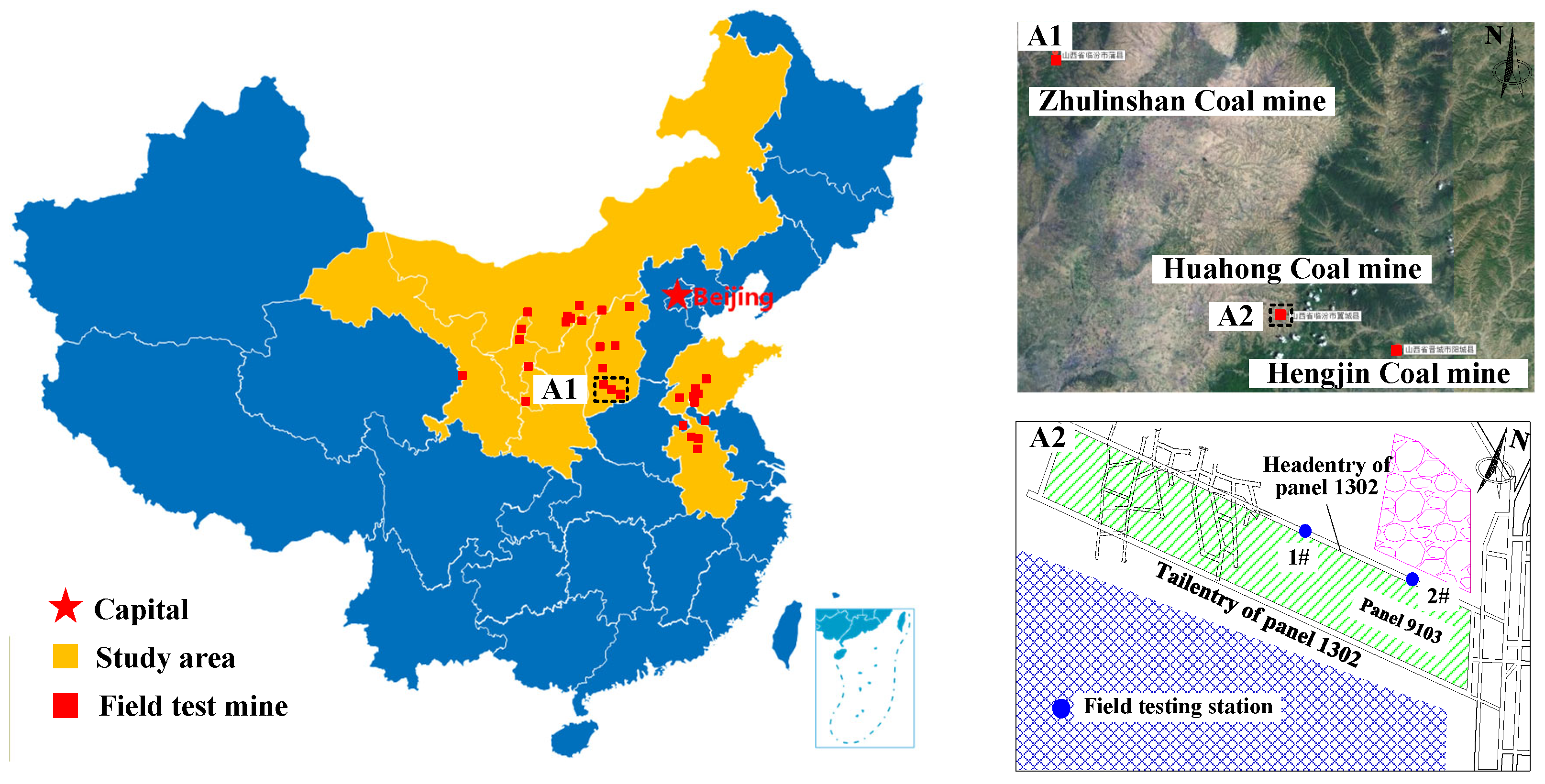
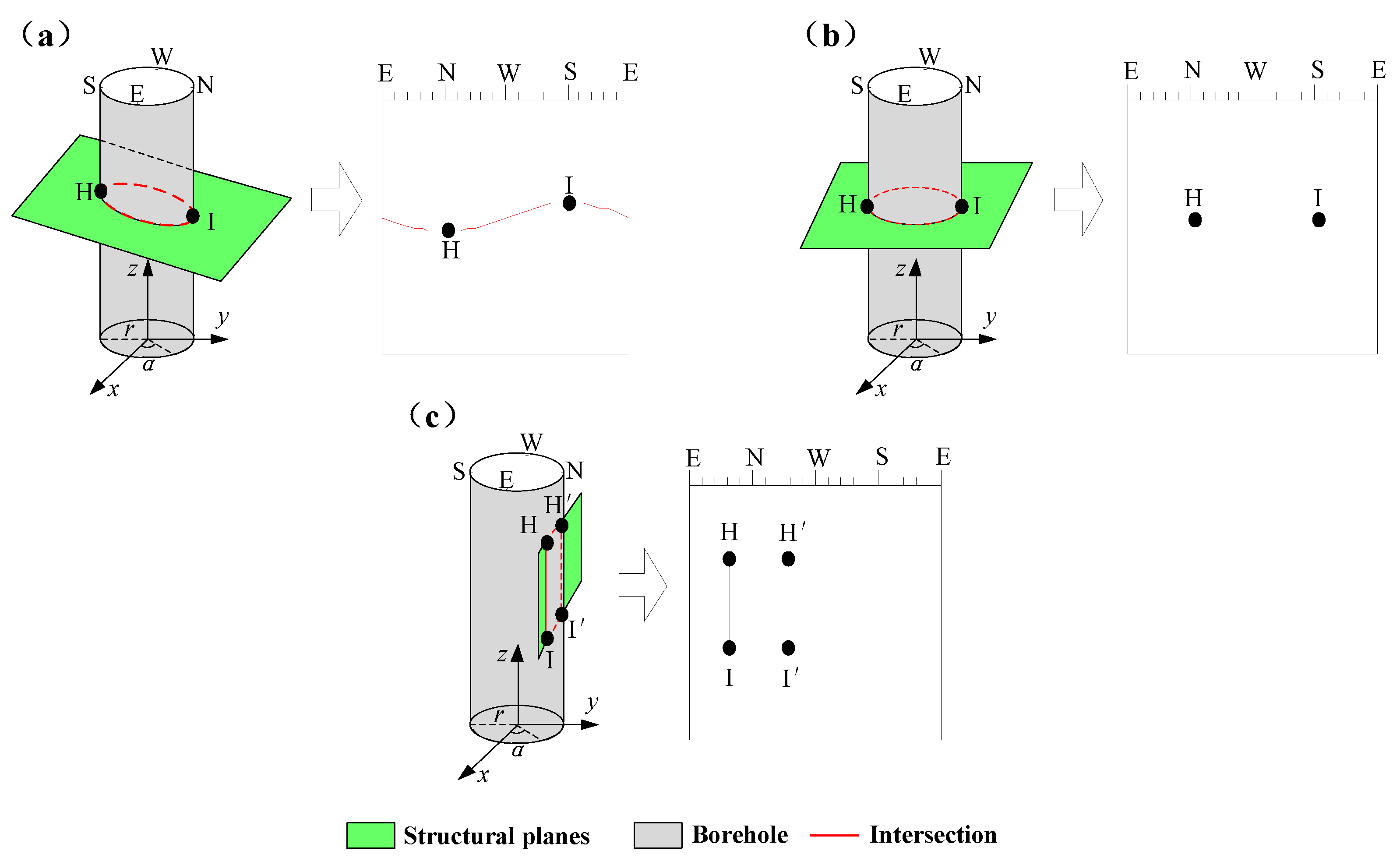
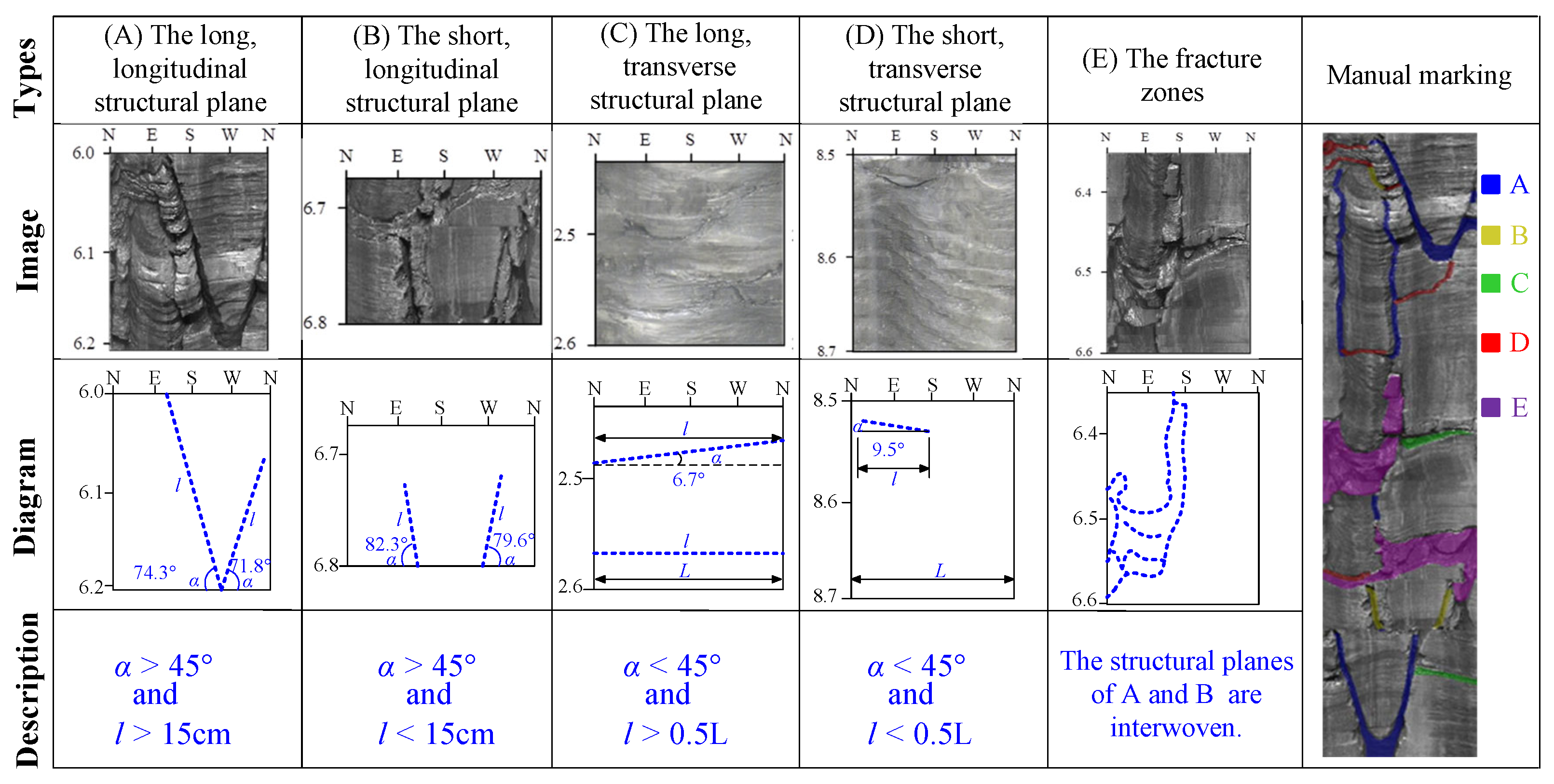
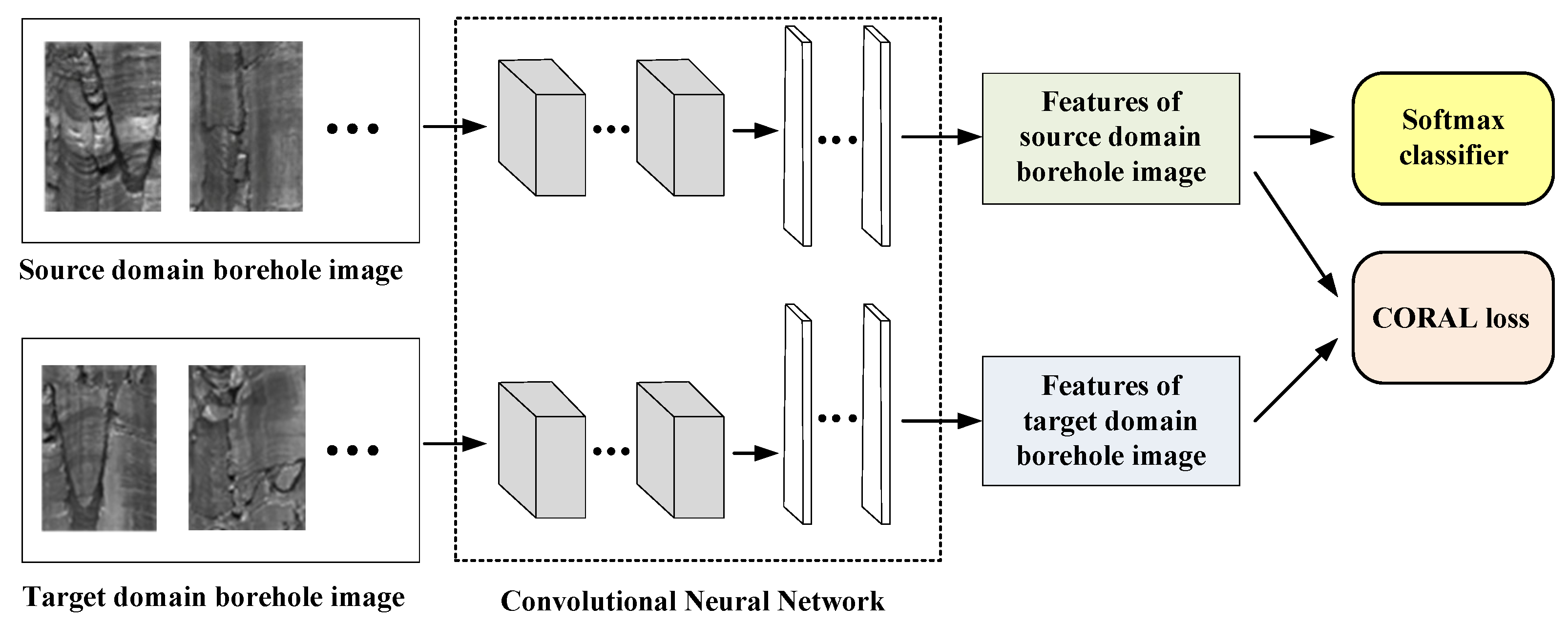
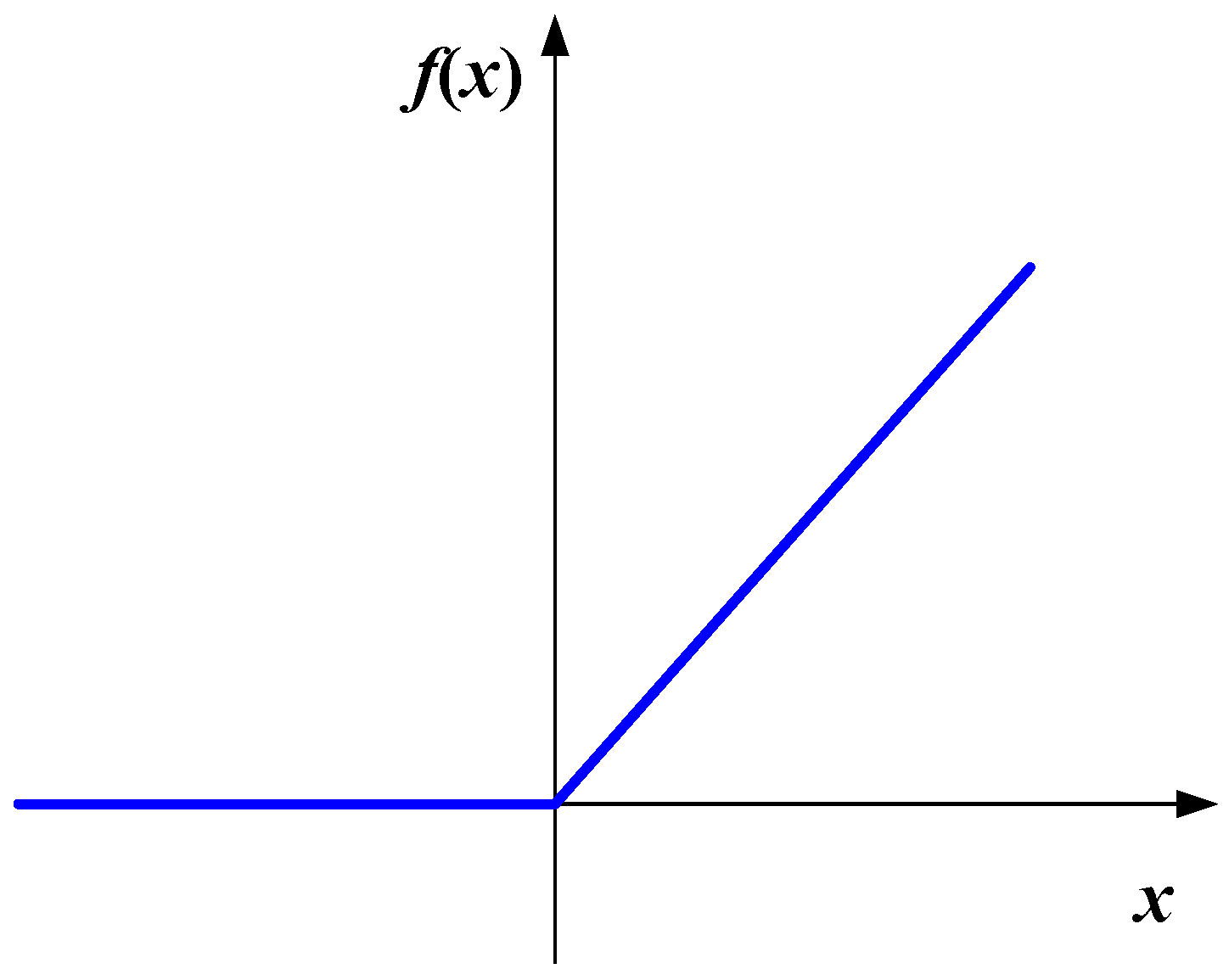
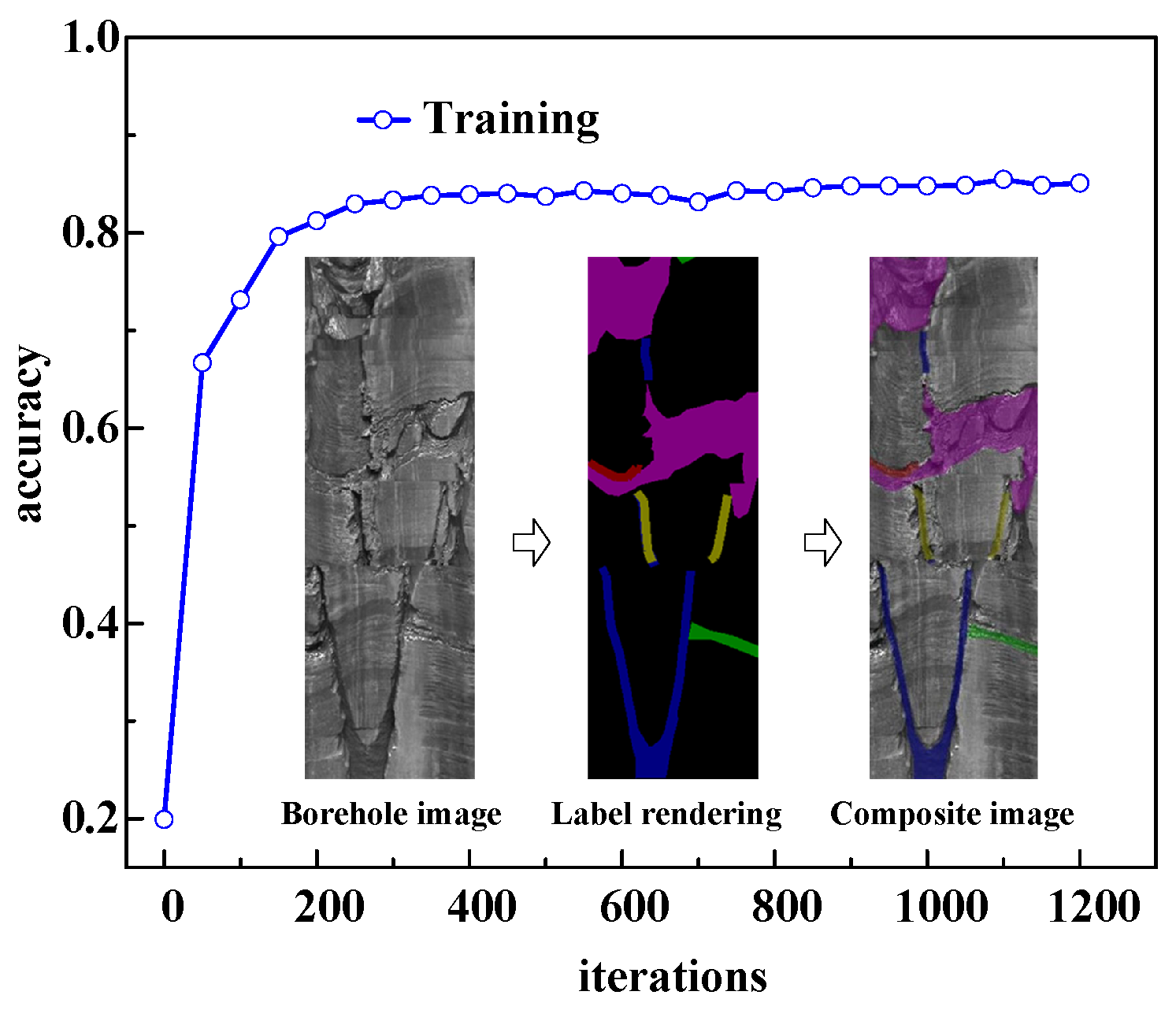
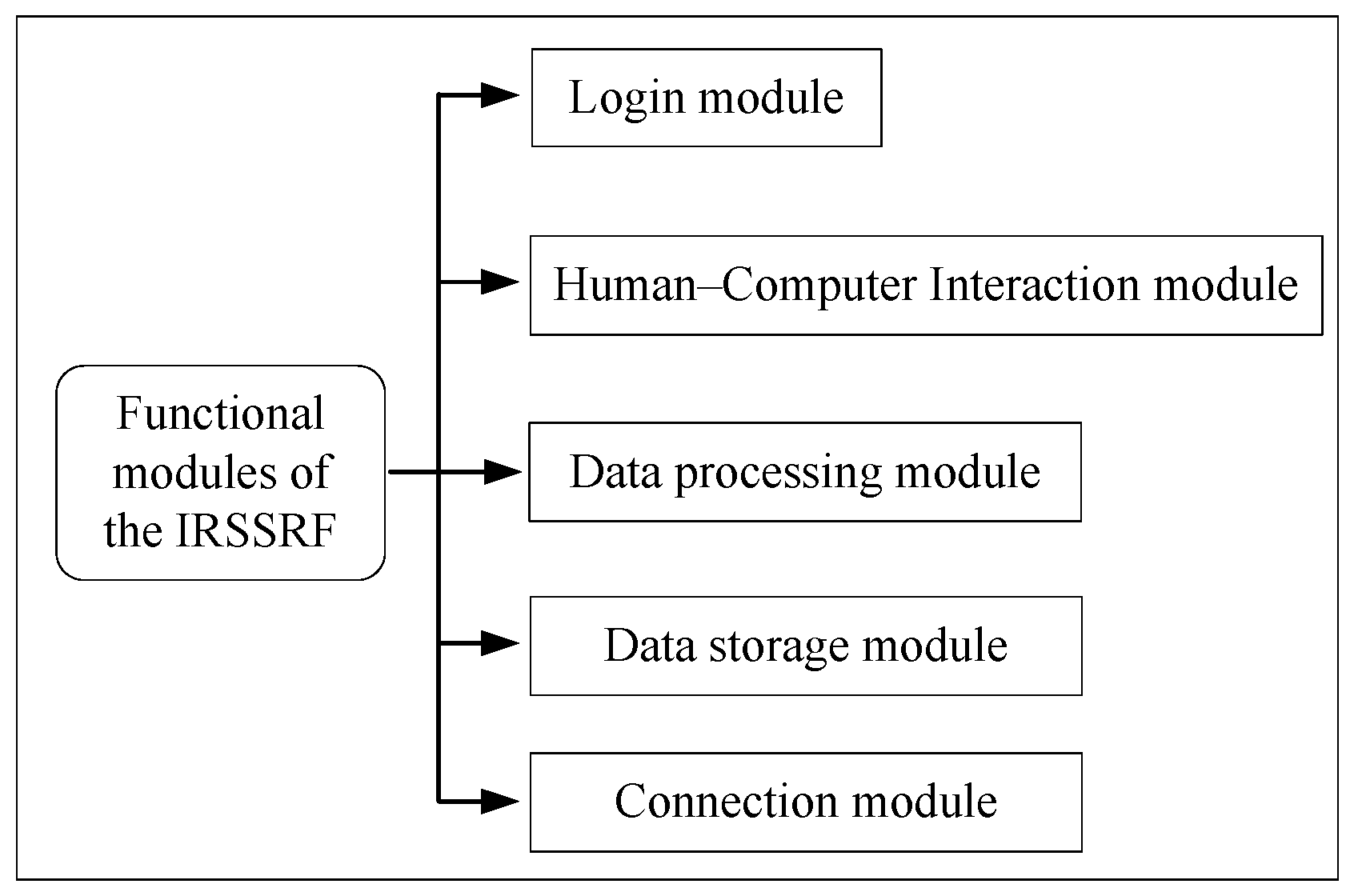
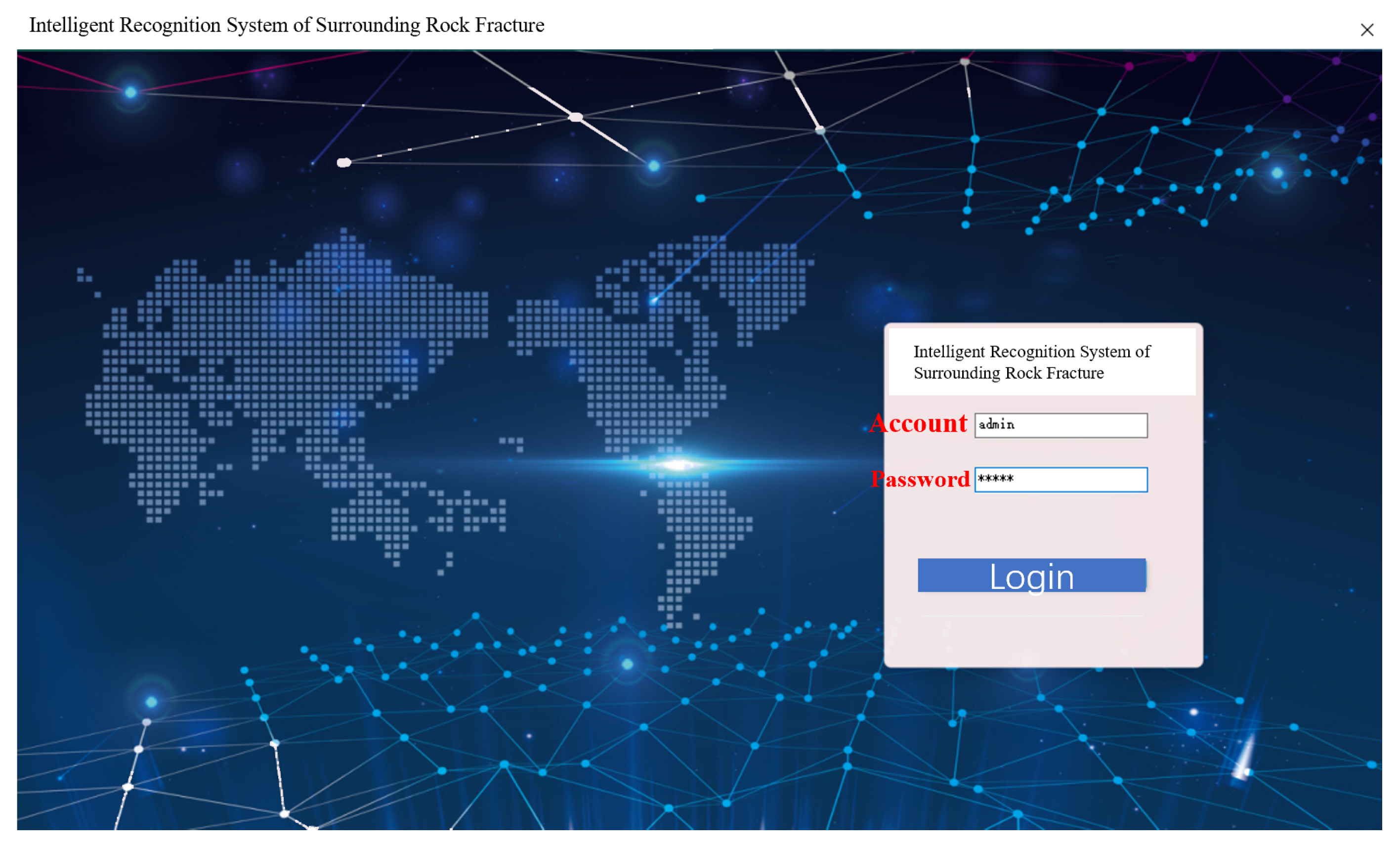
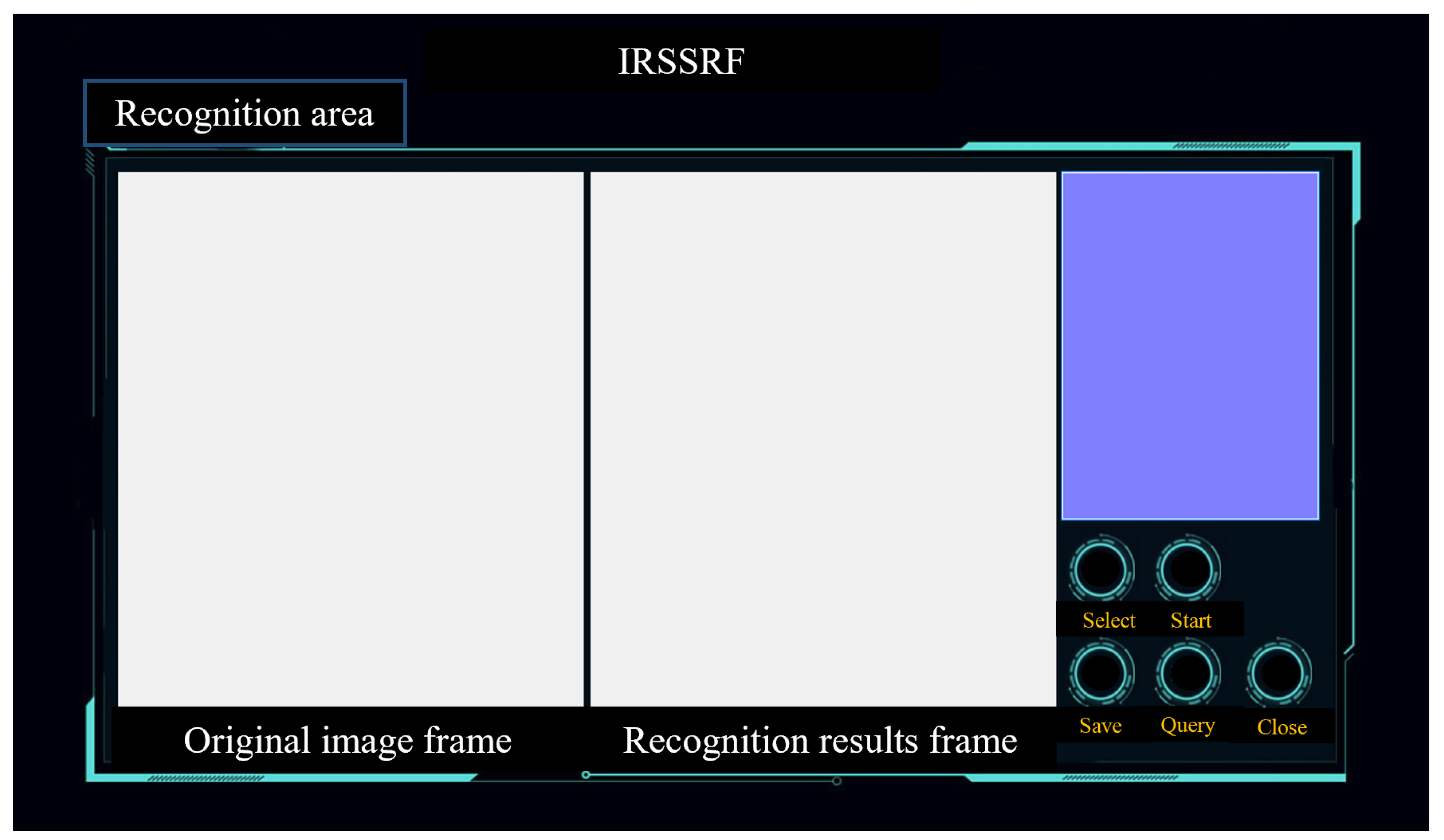
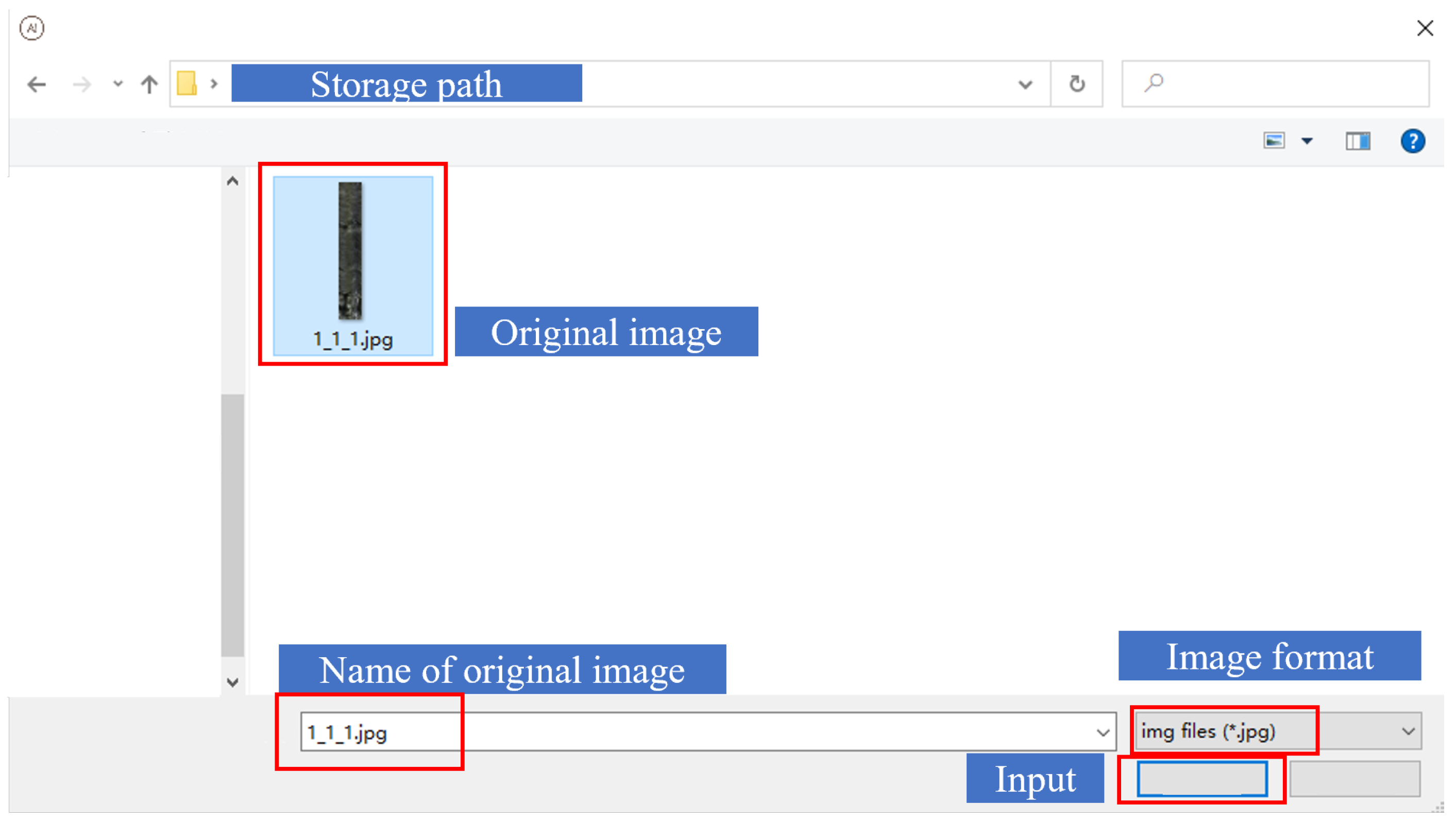
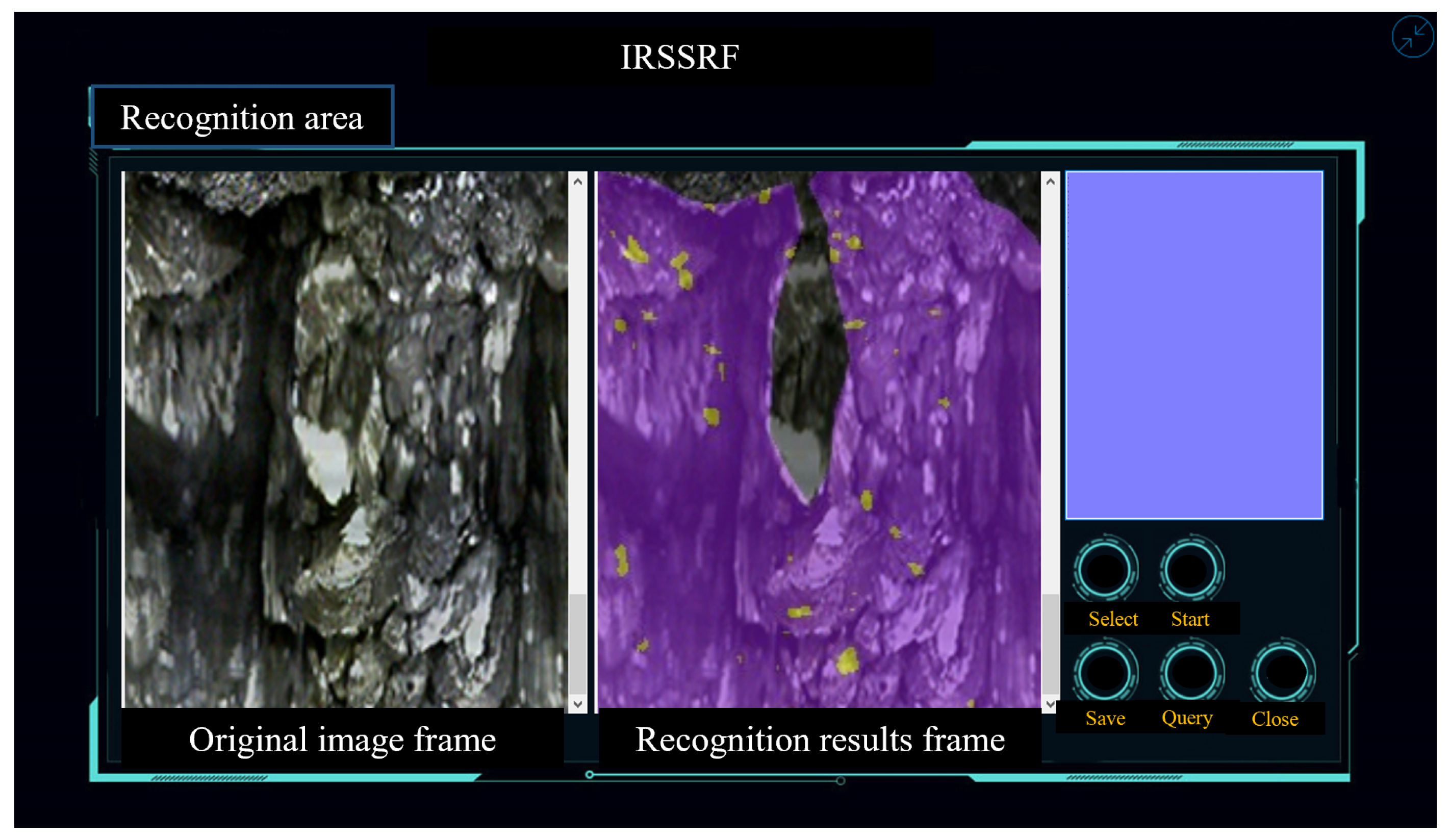
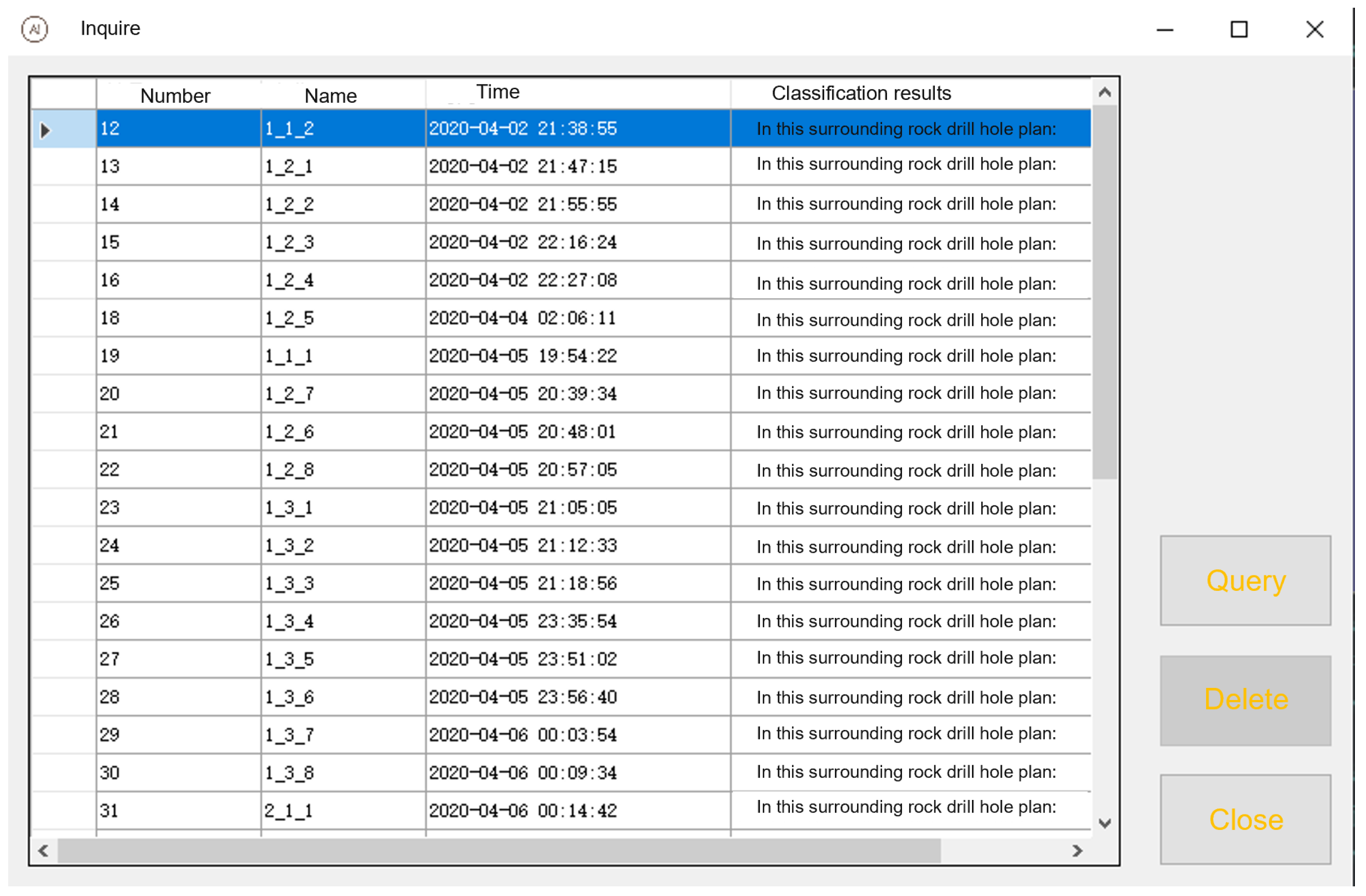
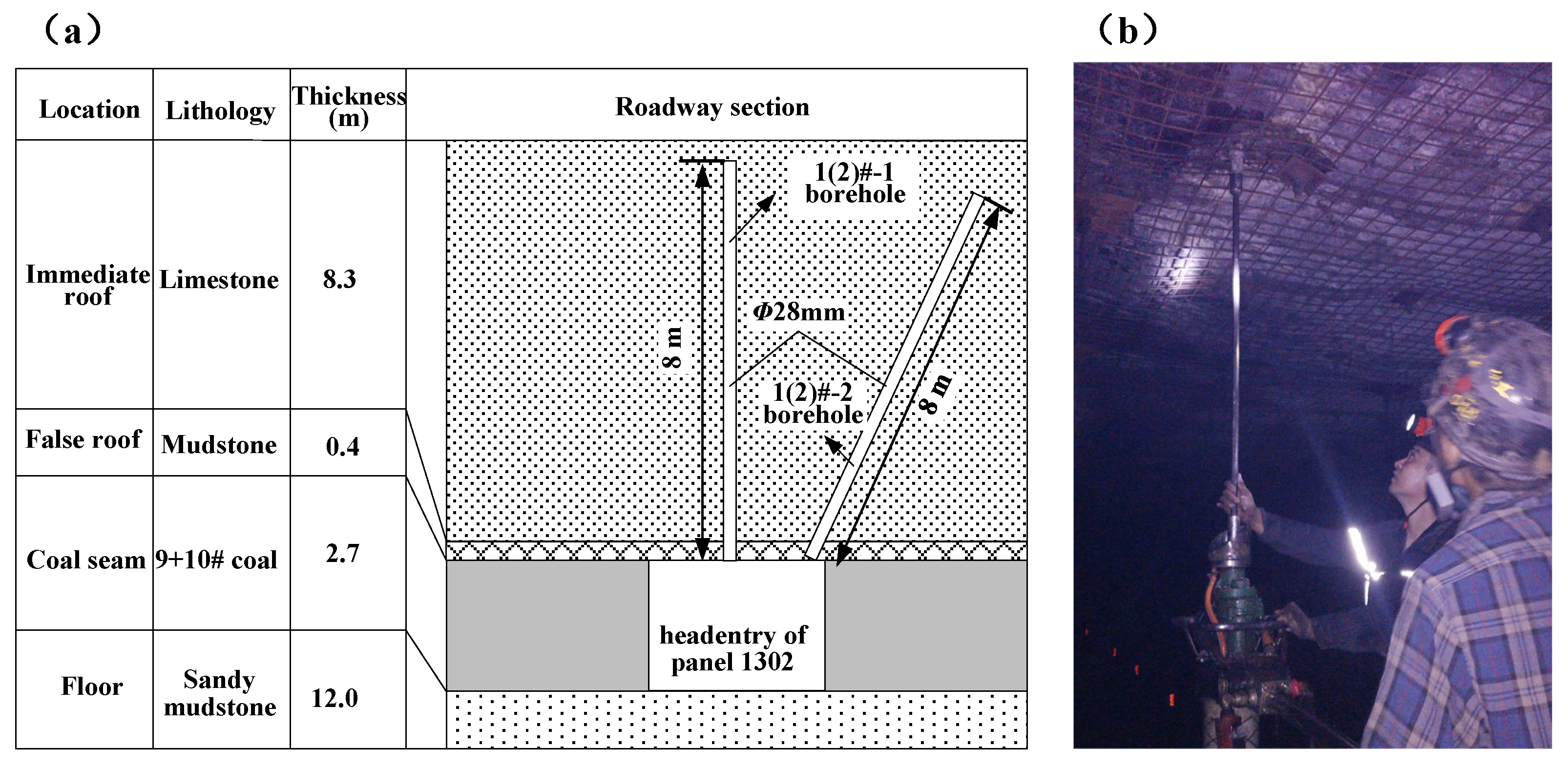



Disclaimer/Publisher’s Note: The statements, opinions and data contained in all publications are solely those of the individual author(s) and contributor(s) and not of MDPI and/or the editor(s). MDPI and/or the editor(s) disclaim responsibility for any injury to people or property resulting from any ideas, methods, instructions or products referred to in the content. |
© 2025 by the authors. Licensee MDPI, Basel, Switzerland. This article is an open access article distributed under the terms and conditions of the Creative Commons Attribution (CC BY) license (https://creativecommons.org/licenses/by/4.0/).
Share and Cite
Xu, Q.; Xia, Z.; Huang, G.; Li, X.; Gao, X.; Fan, Y. Research and Application of Structural Plane Identification for Roadway Surrounding Based on Deep Learning. Appl. Sci. 2025, 15, 4756. https://doi.org/10.3390/app15094756
Xu Q, Xia Z, Huang G, Li X, Gao X, Fan Y. Research and Application of Structural Plane Identification for Roadway Surrounding Based on Deep Learning. Applied Sciences. 2025; 15(9):4756. https://doi.org/10.3390/app15094756
Chicago/Turabian StyleXu, Qiang, Ze Xia, Gang Huang, Xuehua Li, Xu Gao, and Yukuan Fan. 2025. "Research and Application of Structural Plane Identification for Roadway Surrounding Based on Deep Learning" Applied Sciences 15, no. 9: 4756. https://doi.org/10.3390/app15094756
APA StyleXu, Q., Xia, Z., Huang, G., Li, X., Gao, X., & Fan, Y. (2025). Research and Application of Structural Plane Identification for Roadway Surrounding Based on Deep Learning. Applied Sciences, 15(9), 4756. https://doi.org/10.3390/app15094756





